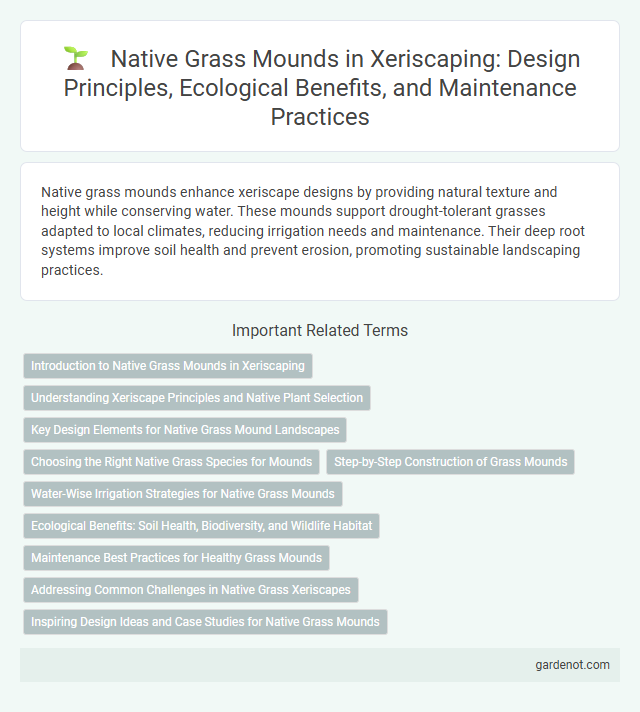Native grass mounds enhance xeriscape designs by providing natural texture and height while conserving water. These mounds support drought-tolerant grasses adapted to local climates, reducing irrigation needs and maintenance. Their deep root systems improve soil health and prevent erosion, promoting sustainable landscaping practices.
Introduction to Native Grass Mounds in Xeriscaping
Native grass mounds are key design elements in xeriscaping, promoting water conservation by utilizing drought-tolerant grass species adapted to arid environments. These mounds enhance soil retention and biodiversity while reducing irrigation requirements compared to traditional lawns. Incorporating native grass mounds supports sustainable landscaping by mimicking natural grassland ecosystems and improving habitat for local wildlife.
Understanding Xeriscape Principles and Native Plant Selection
Native grass mounds exemplify xeriscape principles by promoting water-efficient landscaping through deep-rooted grasses adapted to arid climates, which reduce irrigation needs and prevent soil erosion. Selecting native grasses such as buffalo grass or blue grama supports local biodiversity and requires minimal maintenance by thriving in native soil conditions. Incorporating these native grass mounds enhances sustainability and conserves water resources while maintaining aesthetic appeal in xeriscape gardens.
Key Design Elements for Native Grass Mound Landscapes
Native grass mound landscapes emphasize contour and elevation to create visual interest and enhance natural drainage. Key design elements include selecting drought-tolerant native species such as little bluestem and buffalo grass, arranging grasses in layered clusters to mimic natural growth patterns, and incorporating organic mulch to retain moisture and suppress weeds. Integrating curved shapes and varying mound heights supports biodiversity and provides habitat for pollinators and wildlife.
Choosing the Right Native Grass Species for Mounds
Selecting the right native grass species for xeriscape mounds requires consideration of drought tolerance, root structure, and growth habits to ensure soil stabilization and minimal water usage. Warm-season grasses like blue grama (Bouteloua gracilis) and buffalo grass (Bouteloua dactyloides) excel in arid environments, providing dense coverage and resilience to heat. Incorporating native grasses adapted to local climate zones enhances ecological benefits, promotes biodiversity, and reduces maintenance demands in sustainable landscaping.
Step-by-Step Construction of Grass Mounds
Construct native grass mounds by selecting drought-tolerant species such as Buffalo grass or Blue grama, then prepare the soil by loosening it to improve drainage and root penetration. Shape mounds to a height of 12-18 inches to enhance water retention and create microclimates that support grass growth in xeriscape landscapes. Mulch around the base with organic material to reduce evaporation, maintain soil moisture, and suppress weeds, ensuring sustainable and low-maintenance native grass mounds.
Water-Wise Irrigation Strategies for Native Grass Mounds
Implementing water-wise irrigation strategies for native grass mounds involves using drip irrigation systems and scheduling watering during early morning or late evening to minimize evaporation. Deep, infrequent watering encourages root growth, enhancing drought tolerance in native grasses typical of xeriscape landscapes. Integrating moisture sensors and mulching around mounds further optimizes water efficiency while promoting healthy grass growth.
Ecological Benefits: Soil Health, Biodiversity, and Wildlife Habitat
Native grass mounds enhance soil health by improving organic matter content and promoting water retention, reducing erosion in xeriscape landscapes. Their deep root systems support biodiversity by providing habitats for beneficial microorganisms, insects, and pollinators essential to balanced ecosystems. These mounds create crucial wildlife habitat, offering food, shelter, and breeding grounds for birds, small mammals, and native insects, fostering ecological resilience.
Maintenance Best Practices for Healthy Grass Mounds
Maintaining native grass mounds involves regular monitoring for weeds, ensuring deep but infrequent watering to promote strong root systems, and periodic aeration to enhance soil health. Mulching around the base reduces moisture evaporation and suppresses weed growth, supporting sustainable moisture levels. Proper trimming in early spring prevents thatch buildup and encourages vigorous growth, sustaining the mound's aesthetic and ecological benefits.
Addressing Common Challenges in Native Grass Xeriscapes
Native grass mounds effectively tackle common challenges in xeriscape gardens by enhancing soil erosion control and improving water retention, which supports drought-resistant landscaping. These mounds provide elevated planting sites that reduce root rot and improve aeration for native grass species adapted to arid environments. Integrating native grass mounds optimizes landscape resilience while minimizing irrigation needs and maintenance costs.
Inspiring Design Ideas and Case Studies for Native Grass Mounds
Native grass mounds create visually striking xeriscape features by combining drought-tolerant species like little bluestem and switchgrass, which offer texture and seasonal color changes. Case studies highlight their effectiveness in reducing water use while enhancing habitat for pollinators, demonstrated in projects throughout arid regions such as the Southwest and California. Integrating native grass mounds into landscape design promotes sustainability and adds naturalistic elevation and movement, inspiring innovative xeriscape transformations.
Native grass mound Infographic

 gardenot.com
gardenot.com